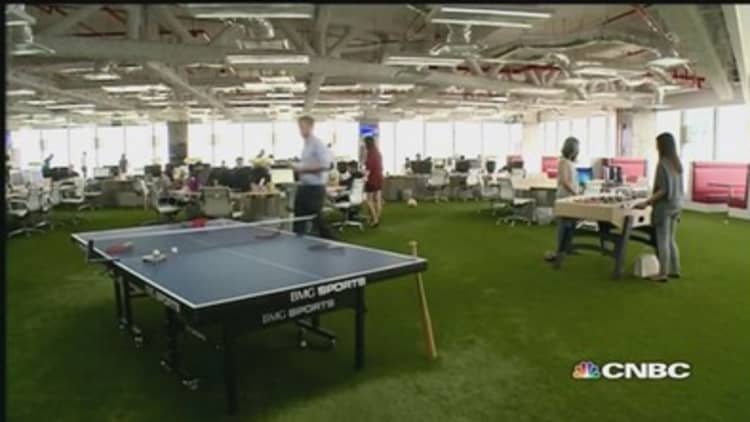Walking through the doors of recruitment firm Spencer Ogden's Singapore office, the space at first glance looks more like a games room than a place for work.
An AstroTurf carpet blankets the floor, dining booths line one side of the office and various forms of entertainment – including a ping pong table, foosball table, bicycle and scooter – are sighted around the premises.
It may seem counterintuitive, but these activities are aimed at keeping employees engaged and productive in the demanding industry. Most days are spent making back-to-back phone calls pitching to clients and trying to getting potential candidates on board.
Tom Reid, Singapore country manager at Spencer Ogden says while the activities can be a distraction, they are positive.
"Recruitment is a tough job but in this sort of environment, you don't get bored and clock watch. You work, and when you need a break, you can get one really easily without leaving the office," Reid told CNBC.

"Most of these activities can be done while working. Everyone here's on a Bluetooth headset so they can be engaging with clients or candidates while riding a bike or scooter, or walking around the office," he said.
Cool office trend
Innovative office spaces are a growing trend, as companies look to set themselves apart, says Larissa Murphy, Southeast Asia director at design house HBO+EMTB, which specializes in workspace architecture.
Firms in the technology sector, such as Google and , as well as in creative industries such as advertising and media are leading the way with "cool" workspaces, she said.
Read MoreAsia, say hello to more Google-like offices
But how much does a quirky workplace design actually impact employee productivity?
"Creating an interesting, inspiring environment of course will make people more productive," said Murphy.
But more than a quirky workplace, studies have shown what helps productivity most is when you give employees a say in the design of their workspace – for example, something as small as the color of cushions, or the placement of interior plants and artwork, said Murphy.
Spencer Ogden, meanwhile, says their investment into creating a fun workspace has paid off both in terms of productivity and retention.
"I strongly believe that creating a positive working environment brings benefits: I have seen it increase staff productivity by 30 percent," said David Spencer-Percival, CEO and co-founder of Spencer Ogden.
Productivity in the recruitment industry is measured by a few metrics including the number of clients brought in, the number of CVs sent to companies, the number of CVs converted into interviews and the number of placements made.
Spencer-Percival reached the 30 percent figure by comparing his firm's productivity metrics with Huntress Group – another staffing agency he co-founded that does not have highly-customized offices.
Meanwhile, the office boasts a retention rate of 93 percent – well above the industry average of around 75 percent.
The Spencer Ogden model
Spencer Ogden's model works well for their business given the office's younger demographics and the nature of the job, which allows employees to be mobile while working, said Murphy. However, this model will not work for all industries, she said.
"For creative industries, their offices are expected to be whacky. But industries such as financial services or law come with a different set of expectations," she said. "If you go into a law firm that looks like a playground, you may walk away questioning their quality of service."
Office demographics also play an important role in determining an appropriate workplace design.
"If there's a large portion of the workforce that's not in their 20s or 30s, it's important to not to alienate them because those are the people with the knowledge," she said.
Instead of "fun" elements such as ping pong or foosball tables, the focus can go elsewhere, she said.
"There's a big move to what is called 'activity-based working', where you provide an array of work settings for employees depending on what they are trying to achieve. For example, creating separate areas employees can go to if they want to concentrate, brainstorm or do presentations."


